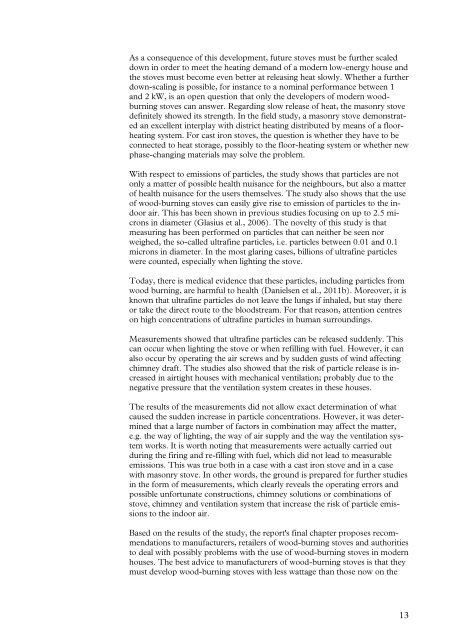Boligopvarmning ved brændefyring - VBN - Aalborg Universitet
Boligopvarmning ved brændefyring - VBN - Aalborg Universitet
Boligopvarmning ved brændefyring - VBN - Aalborg Universitet
You also want an ePaper? Increase the reach of your titles
YUMPU automatically turns print PDFs into web optimized ePapers that Google loves.
As a consequence of this development, future stoves must be further scaleddown in order to meet the heating demand of a modern low-energy house andthe stoves must become even better at releasing heat slowly. Whether a furtherdown-scaling is possible, for instance to a nominal performance between 1and 2 kW, is an open question that only the developers of modern woodburningstoves can answer. Regarding slow release of heat, the masonry sto<strong>ved</strong>efinitely showed its strength. In the field study, a masonry stove demonstratedan excellent interplay with district heating distributed by means of a floorheatingsystem. For cast iron stoves, the question is whether they have to beconnected to heat storage, possibly to the floor-heating system or whether newphase-changing materials may solve the problem.With respect to emissions of particles, the study shows that particles are notonly a matter of possible health nuisance for the neighbours, but also a matterof health nuisance for the users themselves. The study also shows that the useof wood-burning stoves can easily give rise to emission of particles to the indoorair. This has been shown in previous studies focusing on up to 2.5 micronsin diameter (Glasius et al., 2006). The novelty of this study is thatmeasuring has been performed on particles that can neither be seen norweighed, the so-called ultrafine particles, i.e. particles between 0.01 and 0.1microns in diameter. In the most glaring cases, billions of ultrafine particleswere counted, especially when lighting the stove.Today, there is medical evidence that these particles, including particles fromwood burning, are harmful to health (Danielsen et al., 2011b). Moreover, it isknown that ultrafine particles do not leave the lungs if inhaled, but stay thereor take the direct route to the bloodstream. For that reason, attention centreson high concentrations of ultrafine particles in human surroundings.Measurements showed that ultrafine particles can be released suddenly. Thiscan occur when lighting the stove or when refilling with fuel. However, it canalso occur by operating the air screws and by sudden gusts of wind affectingchimney draft. The studies also showed that the risk of particle release is increasedin airtight houses with mechanical ventilation; probably due to thenegative pressure that the ventilation system creates in these houses.The results of the measurements did not allow exact determination of whatcaused the sudden increase in particle concentrations. However, it was determinedthat a large number of factors in combination may affect the matter,e.g. the way of lighting, the way of air supply and the way the ventilation systemworks. It is worth noting that measurements were actually carried outduring the firing and re-filling with fuel, which did not lead to measurableemissions. This was true both in a case with a cast iron stove and in a casewith masonry stove. In other words, the ground is prepared for further studiesin the form of measurements, which clearly reveals the operating errors andpossible unfortunate constructions, chimney solutions or combinations ofstove, chimney and ventilation system that increase the risk of particle emissionsto the indoor air.Based on the results of the study, the report's final chapter proposes recommendationsto manufacturers, retailers of wood-burning stoves and authoritiesto deal with possibly problems with the use of wood-burning stoves in modernhouses. The best advice to manufacturers of wood-burning stoves is that theymust develop wood-burning stoves with less wattage than those now on the13
















